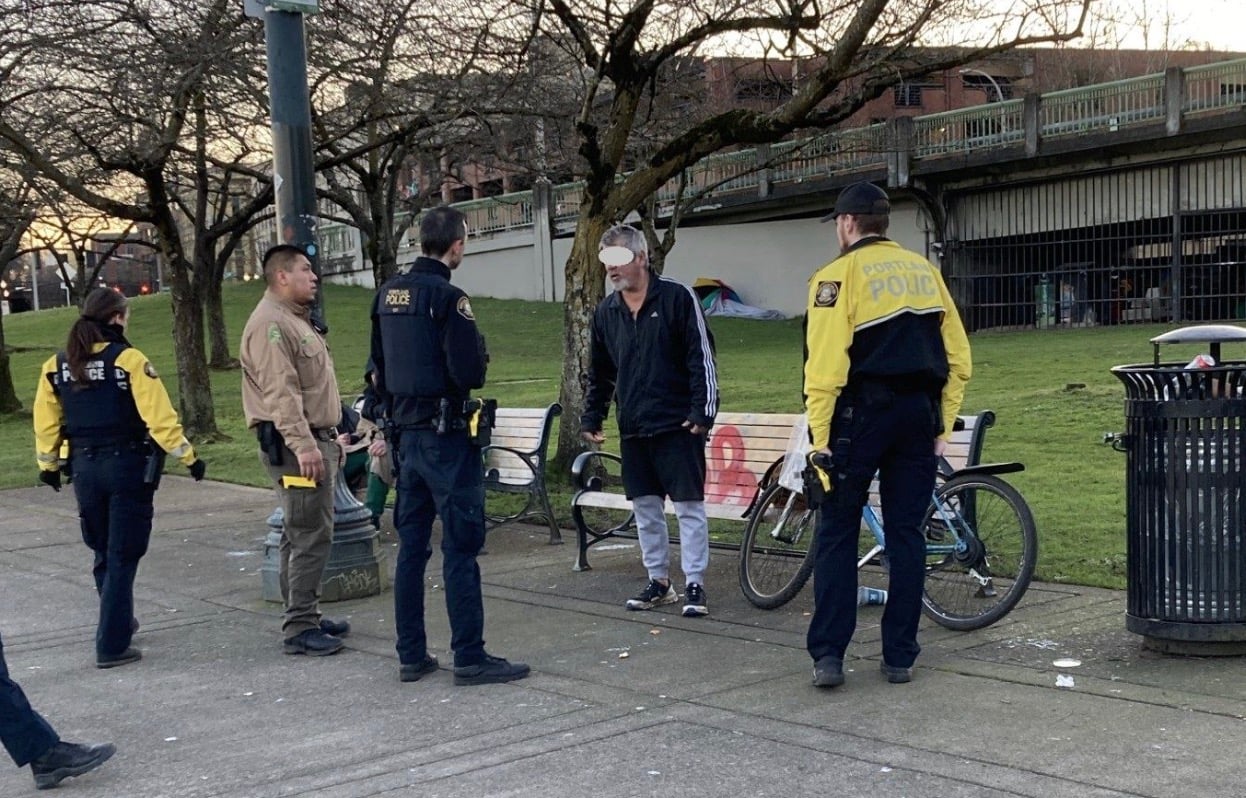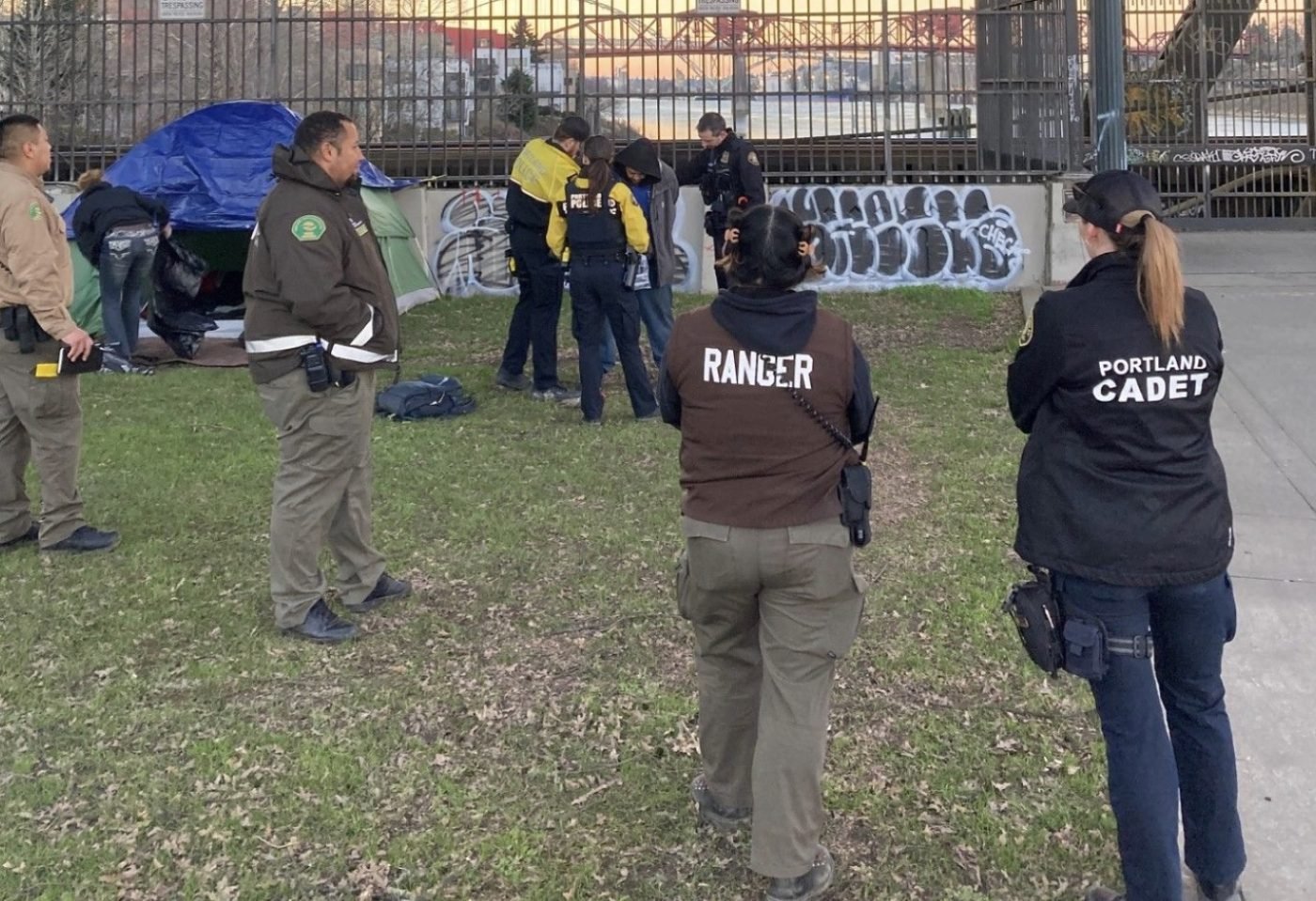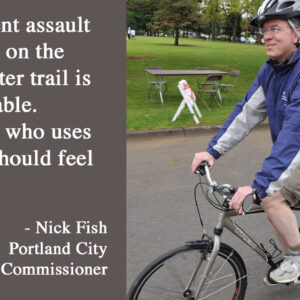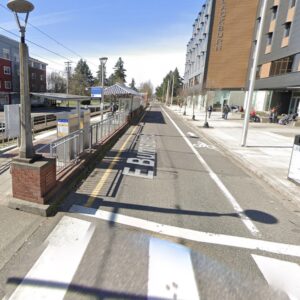
The path through Waterfront Park and the Eastbank Esplanade will see more effective police patrols, thanks to a new collaboration between the Portland Police Bureau and Portland Parks & Recreation.
According to the PPB, members of its Central Bike Squad have been doing walking beats in Portland parks every week for the past several months. It came about when a sergeant on the Central Precinct Bike Squad would do hikes in Washington Park and Forest Park during his on-duty wellness time. (Each PPB officer is given one hour per shift to focus on personal wellness.) During those hikes, the officer met City of Portland park rangers and struck up a friendship with them.
It took a few years of conversations and on-again, off-again partnerships for specific crime issues, but the PPB says the idea was recently rekindled by a park ranger supervisor.
The problem for Portland Park rangers is they often get pushback from some park users when the request identification for various rule violations. And since rangers aren’t law enforcement officers, they have no legal mechanism to compel someone to identify themselves. That’s where police officers come in.
“So the Rangers asked the Officers to go out with them from time to time and patrol Pioneer Square, the North Park Blocks or Couch Park because that’s where most of the issues were,” wrote PPB Public Information Officer Sgt. Kevin Allen in an email about the initiative sent to local media outlets today. “It’s a powerful partnership because some problems can be dealt with by the Rangers, others are better handled by Police, and sometimes a combination of both. And it shows inter-Bureau collaboration and alignment under our shared values of public safety for the community.”
Sgt. Allen said there have been numerous examples of how this collaboration has led to the ability of both bureaus to more effectively reduce crime and address issues in parks.
Safety on central city paths has been a big concern for many bicycle riders over the years.
Have you seen these new walking beats in action? Have you noticed any improvement in safety in Waterfront Park or the Esplanade?






Thanks for reading.
BikePortland has served this community with independent community journalism since 2005. We rely on subscriptions from readers like you to survive. Your financial support is vital in keeping this valuable resource alive and well.
Please subscribe today to strengthen and expand our work.
Wait: are you saying that Portland law-enforcement agencies do not NORMALLY coordinate with each other?
I would expect park rangers to call in PPB every time they observe an issue that needs to be addressed.
As far as I’m concerned the Park Rangers aren’t much help. I called them once for an ongoing problem in a park, they don’t even answer the phone. They have a voicemail. They never responded. It’s just another failed Joanne Hardesty legacy in my opinion.
I’ve often had very good responses, but also some non-responses, and a couple that made things worse. One problem is that they don’t answer the phone on weekends and evenings, when I think a lot of park issues arise. I also don’t know if they even patrol at those times. If I’m not seeing them on weekends because they’re out patrolling at places with more problems, great. But not sure if that’s true.
I actually tried to call last Friday evening when I was at Powell Butte. There’s a guy camping off one of the trails for several weeks now and on the trail over, some guy, who also looks like he’s likely camping out there, came out of the woods with his bike and hopped on the trail to head down to the Springwater. I called the Parks line and I wasn’t even able to leave a voicemail, the automated message said to call during business hours. Great!
You can report campsites on https://pdxreporter.org or the Campsite Reporter at https://www.portland.gov/homelessness-impact-reduction/report-campsite (which is where the Parks website directs you).
Yes, but that route is crushingly slow. A ranger I saw and spoke with at Tabor a week previous said in the case of campers in more sensitive areas a la Powell Butte, Forest Park, etc., it is preferred that Parks are called ASAP to move the campers out and minimize the impact to the camped in area. Regardless, it’s kinda wild I wasn’t able to leave a voicemail after hours on the Parks line.
I fully agree.
I was just noting that Parks themselves routes you to the links I provided above, so it may be that the rangers say one thing based on their on-the-ground experience, while the folks in City Hall say another based on bureaucracy.
That’s hardly surprising in The City That Works, and is hardly confidence inspiring.
Do you call parks and rec every time you see a campsite? If I did that I would be calling them most days.
Joanne Hardesty has been out of office for two elections now. Give it a rest.
I was in Atlanta this last weekend and I noted that just the mere presence of police on bicycles on the busiest trails got people to behave respectfully even on the busiest and most chaotic section of the Atlanta Beltline (on Easter Sunday it had far more people walking, running, scooting, dog walking, and bicycling per square foot than the busiest Portland Sunday Parkways I’ve ever seen.)
Or maybe us Atlantans just have good manners and etiquette in public spaces.
Truly not a snarky question: is that a normal ratio of city staff to citizen? The top picture it’s 4:1 and the bottom picture it’s 7:1. That seems wildly excessive for a number of reasons:
1. The cost would be off the charts. A 15 minute conversation with someone camping costs tax payers $75 or so
2. It would create a power perception problem. Folks already are often scared of law enforcement. Have seven of them around you would be intensely intimidating and make any kind of normal human interaction more difficult
I understand the idea of working in pairs, but those photos depict something totally different. Super interested to hear what people think about this observation and totally happy to be told I’m off base.
What do the photos depict? I don’t know what’s going on… do you?
I can’t address what’s happening in the top picture but someone is getting arrested in the bottom one. There tends to be more police involved when something like that is happening.
Keep in mind that these photos are from PPB themselves. They’re probably meant to convey the message, “See how we’re on top of things?”
I will add that I don’t think your $75 talking point is a good one.These people are already out on the job. That salary money is already being spent. It’s not like they’re charging by the interaction.
Hmmm, pretty clearly I wasn’t articulate there. My apologies.
@watts The point about what those photos depict is that these patrols apparently aren’t pairs, but work in groups of at least four? Or seven? Or more? That struck me as a ton of staff for interacting with one person and I was curious if that’s protocol? Staged for these photos? Other?
@carter yeah, if these are ppb photos the. Perhaps it is just staged. My point about $75 per is that that is super expensive and they could get a lot more out of our tax dollars if they were operating in many smaller groups, like pairs. Simply more miles covered.
“those photos depict is that these patrols apparently aren’t pairs, but work in groups of at least four? ”
I don’t know how rangers and police generally patrol, but I don’t know how you determine that from these photos without a lot more information about what preceded them. For what it’s worth, when I’ve seen rangers out and about, they are generally in pairs.
It seems entirely plausible that if a situation is developing, that more folks would turn up to lend a hand if they are needed. But I can’t tell if that’s what happened just by looking at these pictures.
I think your observation is good.
Way back in 2012 I was at a Portland city council session where they were casually discussing that every time the city responded to a heart attack, arrest, and any other emergency, which they are obliged to by federal law, it was costing the city an average $24,000 per incident in terms of vehicles, salaries, costs from other agencies, overtime, supervision, maintenance, depreciation, rent, retirement benefits, and insurance premiums, and that East Portland was eating up a disproportionate amount of this funding, and anything the city could do to make city residents healthier and less prone to incidents would on the long term save the city gobs of cash.
If anything, the $75 is a vast underestimate.
The long term cost to taxpayers if they can’t make downtown inviting again is far more expensive than the cost of these employees and/or the discomfort someone may feel because there is a power dynamic in play that they aren’t in control of.
No doubt. That said, if Parks and Police conclude that we need four, five, or six people on foot patrols, that is simply unsustainable financially. We can want it, but it simply won’t pencil out.
We need 4x more police than what we have now and strict enforcement. I won’t ride on trails anymore. I see men masturbating, urinating, starting fires in trails, open drug use, and weapons. 20 year resident of Portland who was a daily bike commenter. Not safe anymore for a solo woman bicyclist. After my tire was punctured by a syringe I gave up. Bike got stolen shortly after anyway from locked garage. Portland has decriminalized crime.
Agree 100%. I have reduced my riding significantly as I don’t feel safe. And the new City Council is already looking at how they can cut the public safety/police budget instead of cutting non-core elements of municipal services. That’s what we get for electing people that have very adversarial positions against our law enforcement professionals (Kanal, Avalos, Morillo, Green, Koyama-Lame, etc)
Mitch Green in particular is more interested in intervening on an issue that happened before he was in office and trying to bully a public university ala Trump, to worry about anyone’s safety on our streets, bike paths or parks.
Yep, Max Steele just wrote about this and it got picked up by The Oregonian as well. I find it concerning these type of people are leading our city.
https://portlanddissent.substack.com/p/mitch-green-makes-a-threat
He is a joke. An antisemitic fascist.
His top priority on the Portland Oregon city council is the war in Gaza.
His virtue signaling is just laughable.
Haha, Green stands up for student freedom of speech in his district, BOO hiss!
It’s Orwellian the way you twist it to be the opposite.
Speaking of twisting, trashing a university library is not “speech”.
Yeah but this wasn’t about that, the comments about this are in bad faith. This was about cracking down on student protesters because one person used “amplified sound”. It’s clearly part of a broader campaign to harass student protesters. If this was about the library, certainly that would be a legal matter that would target specific individuals who did something illegal, but instead this was some nebulous nonsense targeting a whole group.
Luckily someone stood up to them.
It’s bizarre people can say its “ala Trump” to protect students from collective punishment for speech. It’s literally upside down and backwards.
Green is threatening to withhold funds from a public institution because of a personal vendetta. Exactly like Trump.
Greens rant about withholding funding was a specific reference to the people charged with vandalizing the library so I have no idea what you are referring to?
Ok, I’ll agree that protestors shouldn’t be prosecuted for using amplified sound if you agree they should be for damaging the library.
And while we’re at it, maybe we can agree that none of this has any bearing at all on where the public would most benefit from siting a performing arts center.
Whether they should be punished in some way is a matter of politics and probably you opinion hinges on if you agree with the cause of the student protests.
I appreciate a politician using their power to do politics, instead of pretending there is nothing they can do. It should happen more often for things like transit safety, bike infrastructure, etc. So if the leverage they have is withholding funding, that’s what they should do to effect change. Let’s not play dumb and pretend this isn’t always how it does and should work.
Authoritarians are great when they have the same politics I do.
Good things are good, bad things are bad. Welcome to having a moral compass.
Also it’s a damned joke and ahistorical to call using leverage (i.e. the legal authority to direct funding) authoritarian. If they didn’t fully have the authority to choose how they vote on things like funding, the comments by Green would be meaningless. He’s doing exactly what a representative should do.
He’s doing the opposite. He’s conflating issues that have nothing to do with each other and guiding public policy around that mistake.
No, it’s not. It is a question of law. Declaring it political is exactly what makes Green’s position — and yours — Trumpy.
It’s worth noting that you are unwilling to concede that inflicting considerable damage to the PSU library is a criminal act. Luckily Green does not have the power to issue blanket pardons.
Play dumb? How it should work? Emphatically neither.
You and I have very different concepts of civil debate and the rule of law. And you don’t get to destroy a public university library just because you don’t like what Israel is doing in Gaza.
I don’t know if you’ve been keeping up (seems like no) but the legal case was already dropped long ago. So no it is not a legal criminal issue.
Nowhere did I say I don’t think vandalism is illegal. But that’s not the question. The question is collective punishment through administrative means by the university, and Green (and I) don’t think that should stand. There is plenty of precedent for the government using the power to direct funding as a way to extract certain behavior. If you think that is Trump like behavior, read a history book.
You and I and Mitch Green all appear not to be keeping up: While there is still one outstanding prosecution, this are no longer, apparently, a current disciplinary issues. Therefore, it is unclear to me, at least, what specifically Green wants from PSU in exchange for not embargoing a performing arts center for the people of Portland.
We agree that collective punishment is wrong, whether pursued by the left or the right. People should be treated as individuals. We also appear to agree that vandalism should be prosecuted, and (I’m guessing if you support prosecutions) that it is reasonable for universities to sanction those individuals involved in destruction of property (but not for generally being part of a protest unless their specific conduct justifies it).
Once again, find ourselves in agreement! I’m OK if you don’t find Green’s attempted blackmail to be Trumpy. I, along with many others, see the parallels. I don’t think it’s the role of City Council to be involved in discipline issues on the PSU campus, just as I don’t think it’s the federal government’s role to have a voice in punishing campus protestors, much less use their resources to coerce universities.
https://www.oregonlive.com/politics/2025/04/portland-city-councilor-threatens-psu-project-funding-over-pro-palestinian-occupation-response.html
Yeah, I see the story was updated. Of course they would say the “conclusion” of the cases had nothing to do with Green’s statement, and that any temporal overlap is purely coincidental. Maybe, maybe not. The specific disciplinary actions, reasons, etc, are all secret. We just know what was said, and what happened after, and we’ll never be able to connect those dots for sure.
It’s a university disciplinary procedure; you and I are not meant to connect the dots.
It’s not a matter of politics. It’s a matter of right/wrong and social responsibility.
1.2 million in damage to the library is free speech?
He is acting exactly like Trump and Harvard.
Please explain the difference.
vandalism and the destruction of public/private property is not “freedom of speech”.
Will they also be patrolling the streets to apprehend or dissuade motor vehicle drivers who are reckless and dangerous? Because I bike commute daily and every day my life is threatened by drivers. I also pass unhoused people multiple times in my daily commute, and none of them has ever threatened my life. So, the people in the vehicles that are actually killing bicyclists kinda deserve some “patrolling.” The people who need housing and treatment deserve those things.
I will be the first to note that the vast majority homeless people will never threaten anyone, but neither will most drivers. On a per-interaction basis, my life has been threatened by more homeless people than people in cars. There are some obvious reasons for this that do not include homeless people being somehow “bad”.
That said, I completely support stepping up the patrolling of streets where people tend to drive most dangerously. It seems we agree on that point.
Sure, but the cumulative risk is obviously higher from automobiles. Cyclists die biking on the roads from being hit by cars, not from assault by homeless pedestrians.
Indeed. But when given the choice, many people seem to prefer avoiding riding in areas where there are few cars and lots of campers. Perhaps you are the exception.
Car drivers are absolutely a problem. Which is even more reason to make sure the paths are kept in a better state so people feel safe using the paths instead of the streets.
As a regular bike commuter, I definitely face more dangerous situations with cars than homeless. But I regularly ride Springwater and 205 paths and can certainly understand why people don’t feel safe using them. Nearly every time I ride those paths I have at least one interaction with someone hanging out on the path that makes me uncomfortable.
People shouldn’t be able to turn public spaces into their private spaces and deprive everyone from being able to safely, comfortably using those spaces. The state of the paths has definitely improved since the low point during Covid, but they are still in poor condition with camps lining them, people blocking the paths in multiple places, people passed out high or actively doing drugs in the middle of the paths, and aggressive people and dogs hanging out in the middle of the paths.
I wish they’d enforce the leash laws.